Table of Contents
Front loading has recently become a popular way of carrying panniers. The setup has been made trendy by manufacturers like Specialized with their AWOL x POLER touring bike, or any number of the touring bikes featured on bicycle lifestyle website, The Radavist.
But is front loading a better place to locate your gear on a touring bike, or is it just fashion?
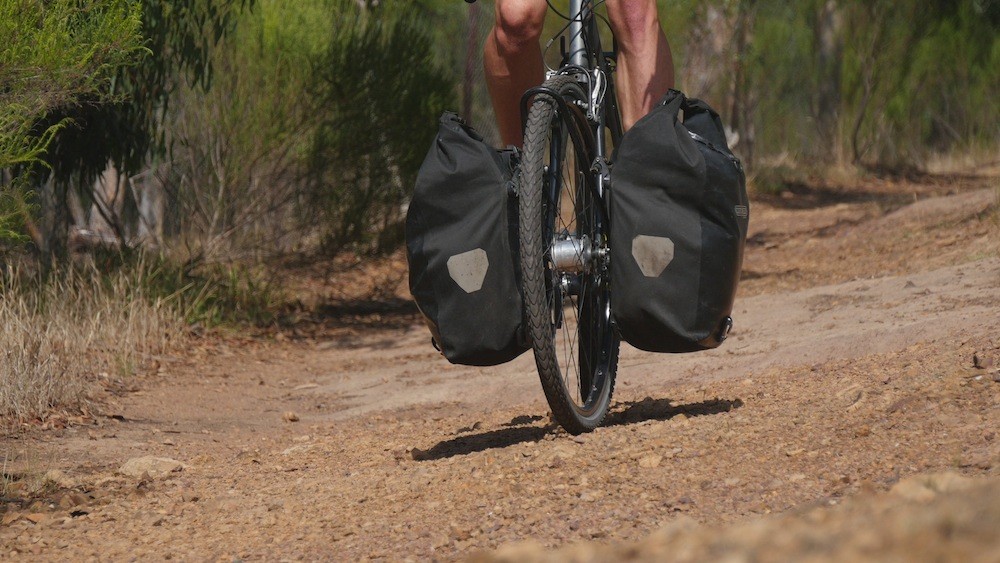
Jan Heine and the crew from Bicycle Quarterly have been talking about the advantages of front loading for a very long time. Jan has found that bikes with “low trail” steering (a measurement derived from the headtube angle, fork offset and tyre width) handle front bags exceptionally.
Having spent some time on “low trail” bikes with a light/moderate load, I tend to agree that the sharp steering and front weight tend to cancel each other out somewhat. But that said, at a certain point (perhaps with 10kg or so) I’ve also found it simply doesn’t matter what fork trail measurement you have – handling with a front load feels very similar between bikes.
I’m going to steer away from the high vs. low trail discussion now, as almost all bikes that people conduct tours on (touring, gravel, hybrid, cyclocross, MTB) offer relatively “high trail” setups.
For my testing, I’ve used my Surly LHT touring bike to undertake different tasks, many of them practical – and I’ll try my best to describe how front and rear loading work under each of those circumstances. My testing has been conducted on short rides, long rides, city rides, dirt road rides, on climbs and on steep descents.
What you’re going to soon notice is that there are many factors at play: front vs rear loading isn’t just about handling.

Open Road Testing
Let’s take a look at how front and rear loading will affect your time on open roads. It’s safe to assume that this type of riding is going to be the majority of what bike travellers conduct. Here are my thoughts after thousands of kilometres of testing.
Handling
When it comes to handling at speed, it’s hard to pick a preferred setup. I got used to both a front and rear load within just a few minutes of riding. What I did notice was that there was a limit to how much weight you can put on the front wheel before it feels unstable – it’s about 10kg. In comparison, you can load up the rear with 20 or 30kg and you’ll find very little change in the handling.
Winner: Tie
Component Wear and Longevity
Given that the majority of our body weight is over the rear wheel when we ride our bikes, adding additional weight to the back of the bike tends to strain the back wheel more than the front. That is why if you’re using a lightweight bike (or lightweight wheels) it’s best to keep your load to the front. Your rear wheel will thank you for it.
Winner: Front Loading
No-Handed Riding
Riding with no hands is a great skill to have in your arsenal, as it allows you to stretch out your back and take strain off your neck/wrists at times. More practically, you can use the skill to open wrapped food, or even take photos. Either way, having weight on the front of the bike makes this task much more difficult than if the weight is over the rear wheel.
Winner: Rear Loading
Standing Up
If you’re a cyclist who likes to ride out-of-the-saddle from time to time, you’re going to prefer to front load. As soon as you stand up with a rear load, there’s less stabilisation from the handlebars to the rear of the bike, and in turn, there’s more effort required to stop the bike from moving side to side. Flat handlebars improve the overall stabilisation, but really, front loading is king for out-of-the-saddle riding.
Winner: Front Loading
Rider Steering Input
There is a certain amount of effort required to turn the handlebars on a bicycle. As soon as you add any weight to the front of the bike – steering effort increases. It’s sometimes nice having the feeling of heavy steering – on a long windy descent perhaps. But I’ve found it pretty hard to beat effortless steering in almost all circumstances.
Winner: Rear Loading
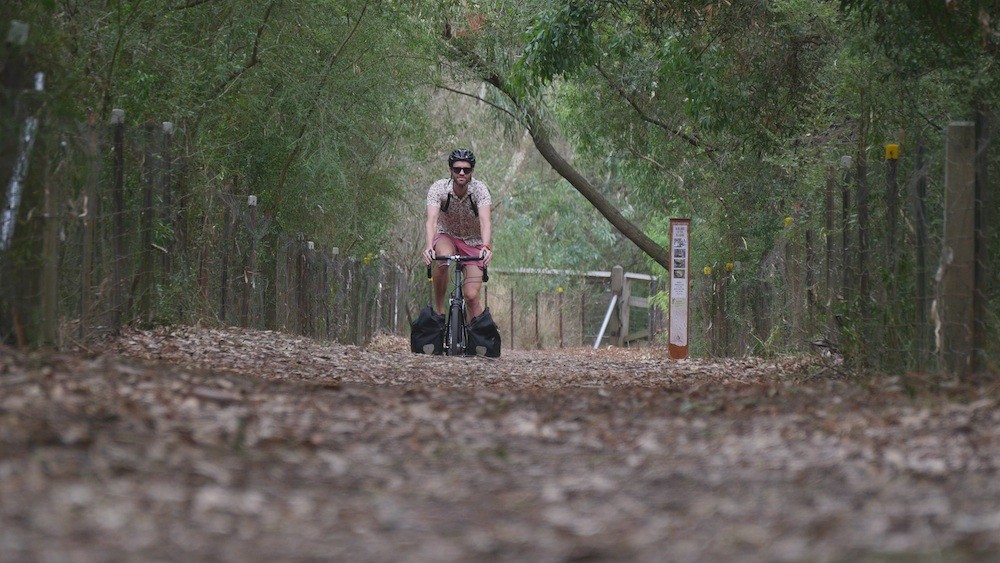
Pannier Balancing
There is a great need to keep your bike’s front panniers ‘balanced’. If the bags are uneven you will experience speed wobbles from resonance frequencies coming up through the front wheel. I think it goes without saying that with front loading you will need to use both bags, whereas when rear loading, you can quickly adjust to the uneven load of a single pannier.
Winner: Rear Loading
Climbing Uphill
When it comes to steep climbs, front loading really shine – especially on the dirt. Front bag weight keeps the front of the bike firmly on the road at all times.
Winner: Front Loading
Steering Speed
I like to make small adjustments to my front wheel as I ride, in order to quickly avoid debris, puddles and bumps in the road. Most often it’s a last-second adjustment because I’m generally fixated on the world around me, rather than the pavement a few metres ahead. With the weight up the back, my bike turns super fast and I can avoid almost anything with only a fraction’s notice.
Winner: Rear Loading
Dirt Roads
Rougher surfaces tend to ride better with weight over the front wheel, especially on steep descents. This is because there is more weight over the front wheel, resulting in more front end grip. This grip will also offer you more confidence, allowing you to carry slightly faster speeds. As dirt roads are sometimes quite rough, it also makes sense to distribute your load more evenly across your bike (panniers up front, body weight up back) so that your front wheel takes its fair share of abuse!
Winner: Front Loading
Storage Space
Although front racks can be found with a top tray to offer storage above the panniers, a rear rack can comfortably take two large panniers, plus a racktop bag and whatever else you want to strap onto it. You’ll easily get 80L of storage on the back if need be.
Winner: Rear Loading
Heel Clearance
This one is rather obvious but worth discussing anyway. If you are not using a touring-specific bike and you have large feet, you could have problems with your heels striking your rear panniers. This is one of the very reasons why a touring bike has long chainstays (435mm minimum). With front panniers you can opt to use any bike you like with very short chainstays.
Winner: Front Loading
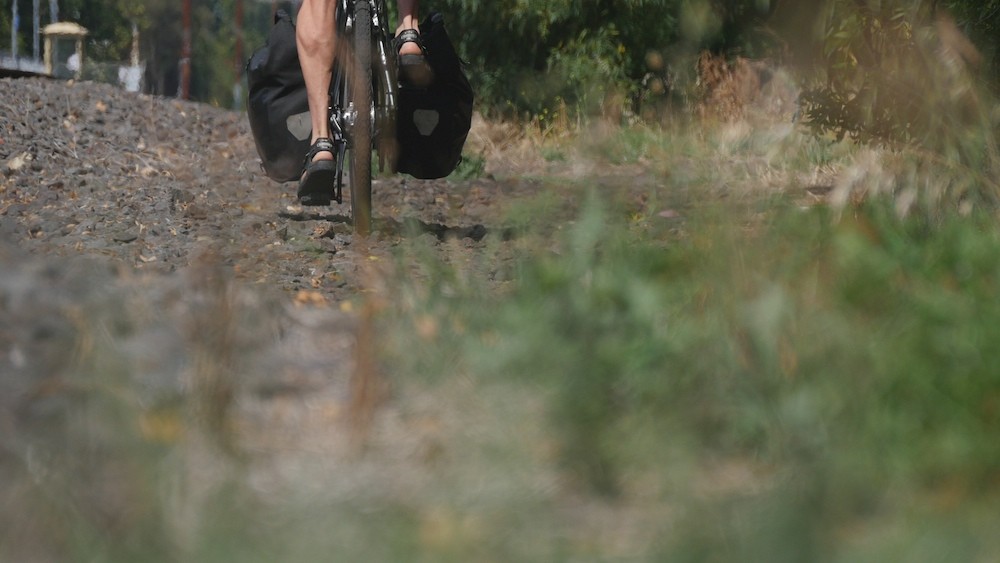
Urban Testing
My urban testing was completed in the inner city areas of Melbourne. I rode along footpaths, roads, alleyways and bike tracks. I split traffic, completed many slow speed maneuvers and stopped/started a lot. Here’s what I’ve found.
Gutters & Ground Clearance
In urban areas, ground clearance is paramount. I often find myself wedged between the traffic and high gutters when I’m moving through built up areas. Front panniers reduce your clearance as they sit lower to the ground – I’ve found it’s much easier to squeeze between cars with the higher-sitting rear bags.
Winner: Rear Loading
Slow Speed Maneuverability
At slow speeds, you use your steering to balance from left to right. With your weight up the back, your steering is light – making it easier to balance your bike. Riding along a busy footpath is the perfect example of a time when slow riding is necessary.
Winner: Rear Loading
U-Turns
Given that the steering is faster and lighter with a rear load, it makes sense that a u-turn is best performed with this setup. Without front panniers affecting your line of sight, you can place your front wheel exactly where you’d like it to be too!
Winner: Rear Loading
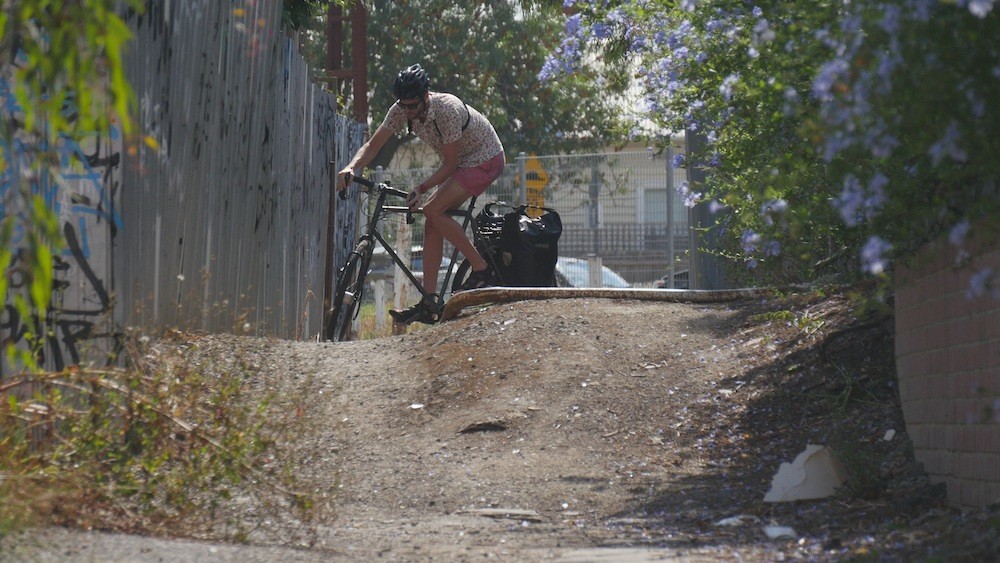
Parking Your Bike
I’ve found that parking my bike with rear panniers is easy – it’s as simple as leaning my rear panniers up against a solid object. There’s no lifting or adjusting, and once leaned, the handlebars and front wheel are less inclined to want to swing about. If you’re a rear kickstand user, you’ll find that front loading tips your bike over because there’s a lack of weight over your rear wheel. Conversely, centre-mount kickstands like the Pletcher ESGE prefer having weight over the front, provided it’s balanced.
Winner: Rear Loading
Stairs
I seem to come into contact with stairs all the time on my bike tours! Most train stations, hotels and built-up areas use stairs to move people up and down levels. I’ve found the most effective way to get a touring bike up stairs is to drag it. With the weight on the rear, you can lift the front wheel slightly, and push the rest along. Front panniers on the other hand will hamper your efforts – you may even need to take them off entirely.
Winner: Rear Loading
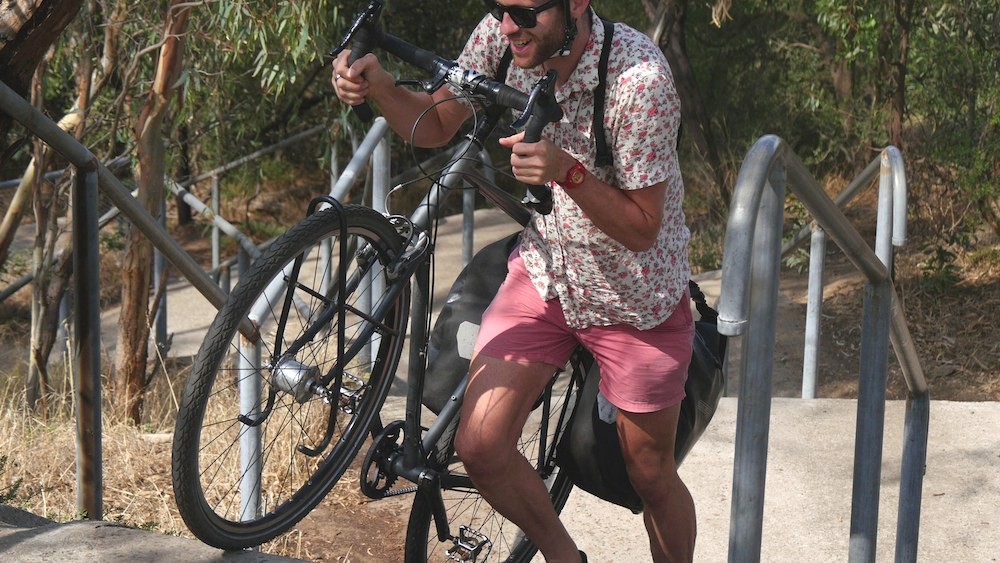
So What’s Best: Front or Rear Loading?
Although front loading excelled through some testing areas, I’ve found it more practical to use a rear rack and panniers (and a small handlebar bag) for a few reasons. On the open roads it’s nice to be able to see where your front tyre is travelling and make quick adjustments to the direction of the bike. I like not having to balance my bags every time I go shopping, and being able to strap whatever I want to the top of my rear rack (heavy or not). I like travelling with a single pannier, and riding effortlessly without my hands on the bars to stretch out my back.
Throughout my urban testing, rear panniers made my life easier across all tests – in particular for anything that required slow speed maneuverability, such as weaving through pedestrians or completing u-turns. As there’s more ground clearance, it’s certainly better to split traffic with a set of rear panniers too.
When Should You Front Load?
There are a couple of instances where I preference front panniers over the rear.
– If I’m mostly spending time on dirt roads
– If my wheels aren’t particularly durable (on a non-touring bike for example)
– If my rear chainstays are short and I don’t have enough heel clearance
Front-loading can be great. I really do like the setup on big, open, dirt roads – luckily my touring bike has the option of both setups. But while there’s currently a bit of a cult following around front-loading, I will continue to use and recommend rear panniers on all but dirt road-specific tours. Happy riding!
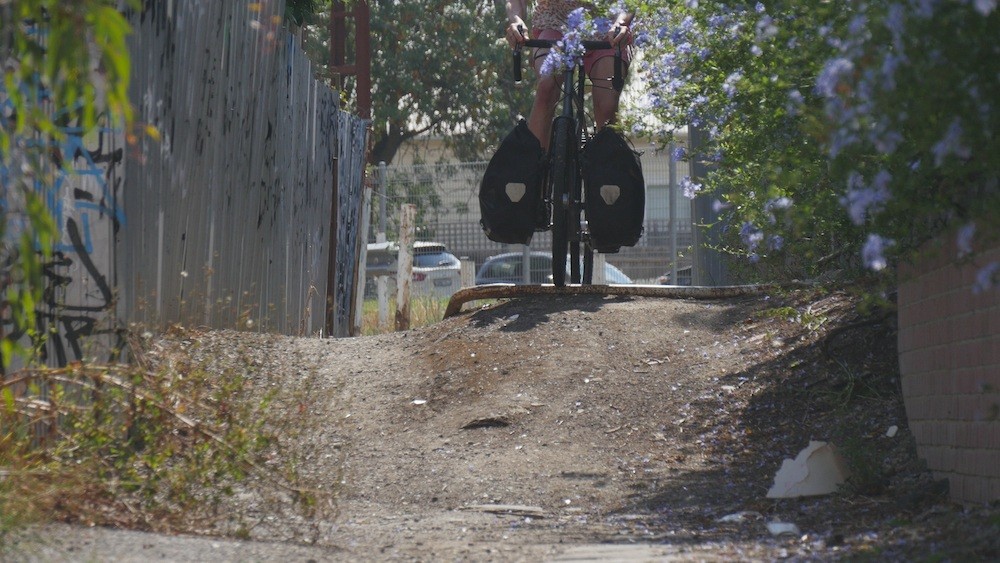


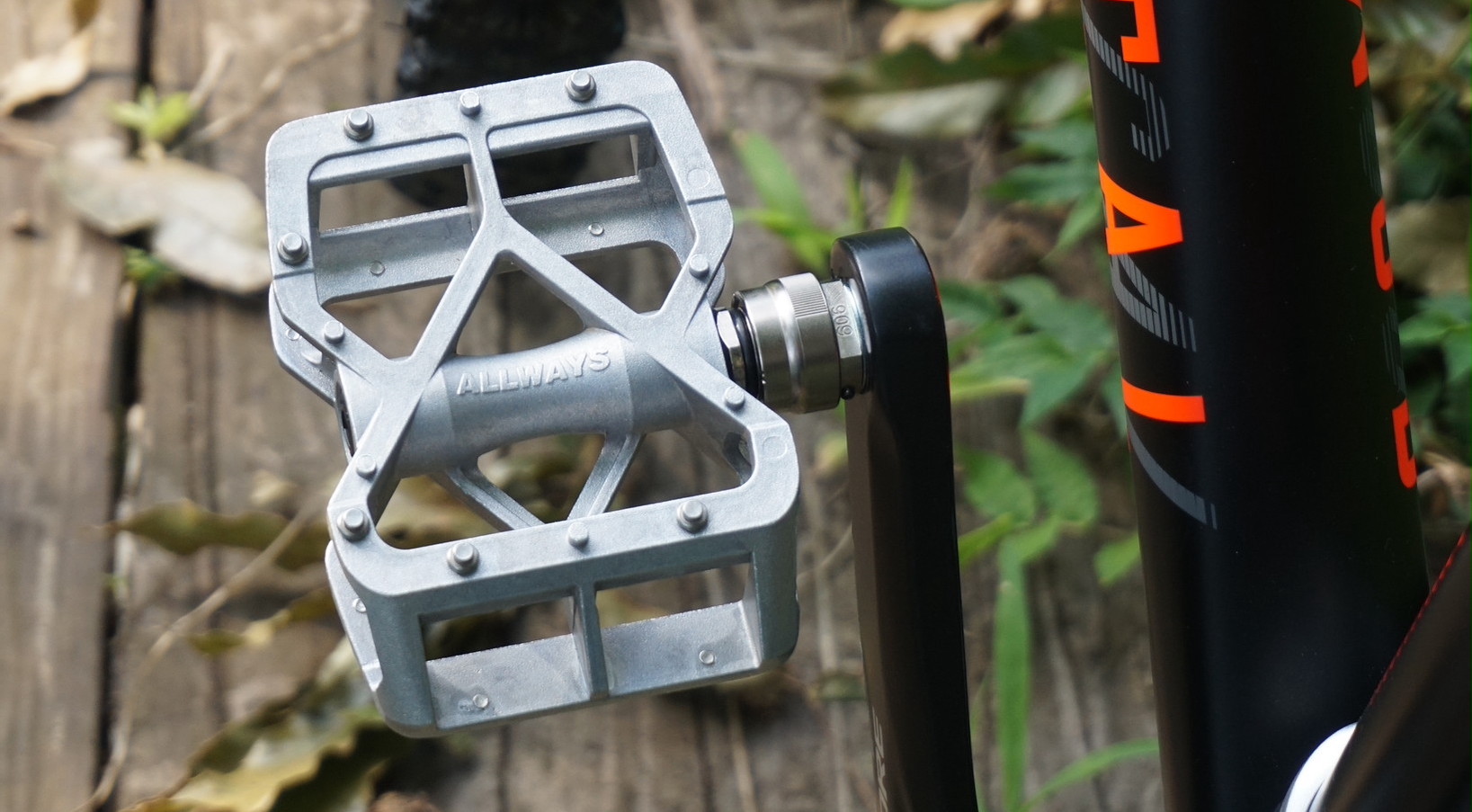
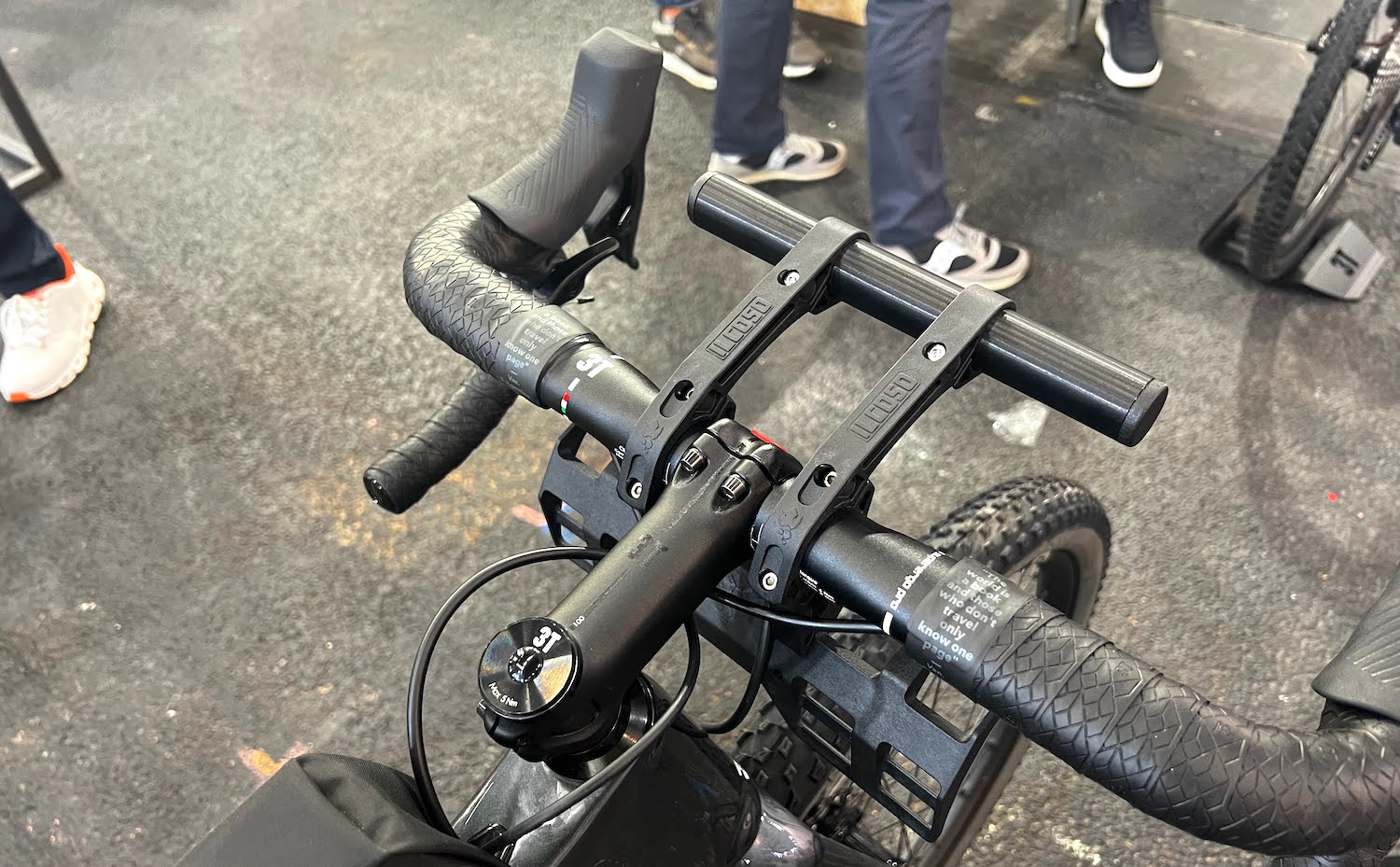
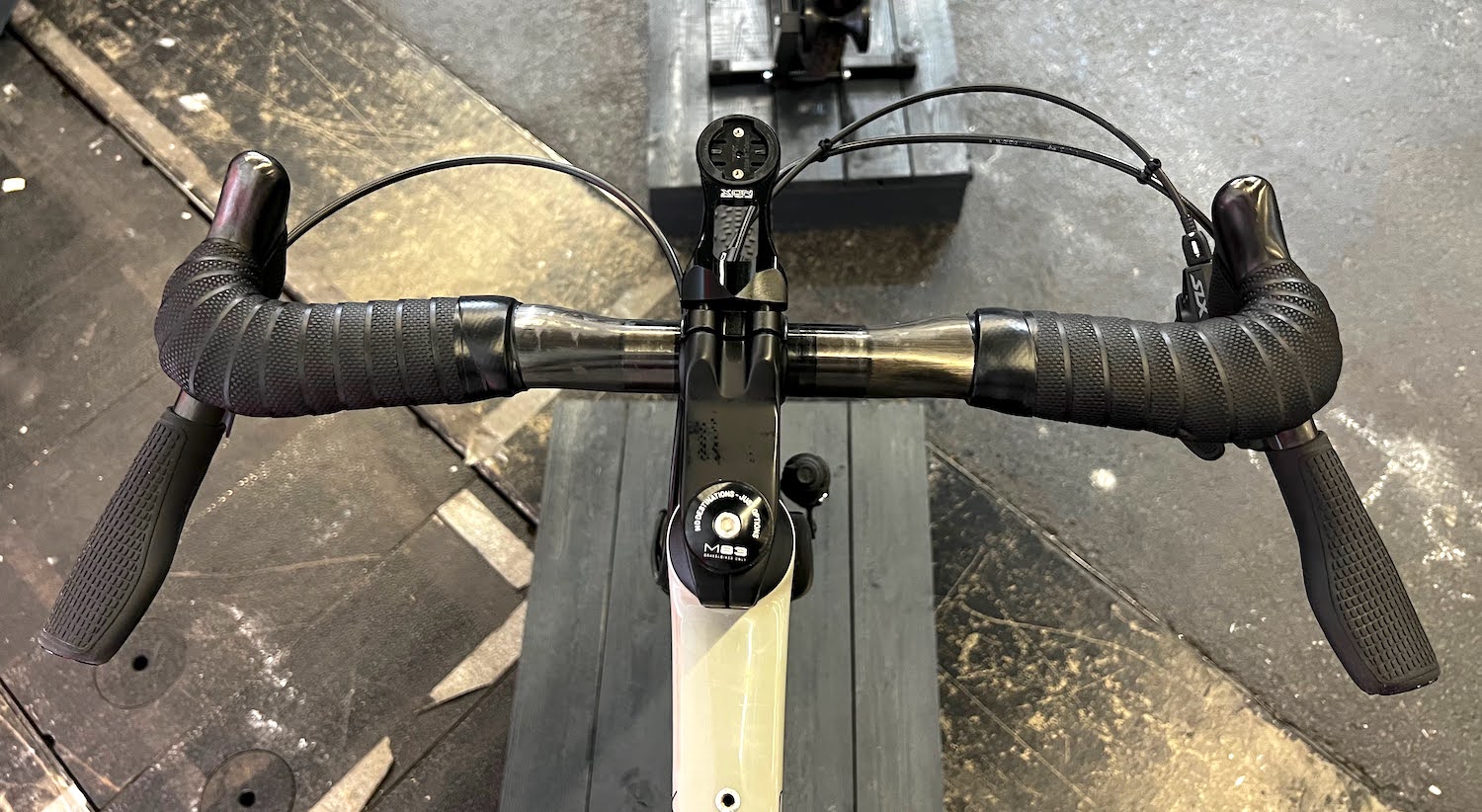

Great article, Alee. Your observations are quite similar to mine as I’ve experimented with multiple configurations. I follow Jan Heine as well and have found many of his ideas intriguing. In fact, I’m seriously considering purchasing a low trail bike, something along the lines of Soma’s Grand Randonneur. Any thoughts?
Dave
You missed one benefit of front loading: you can access your panniers without getting off the bike.
Also, you’re assuming that “front rack” means “low rider rack”. A higher rack doesn’t have the ground clearance issues (but is less good in other ways).
I’m also going to quibble with your scoring rear rack points for not having to balance panniers, or being able to ride with just one pannier. Neither of those really applies for *touring*. (For commuting, I totally agree. I was stuck with using just front rack for a week and it drove me nuts – a heavy laptop on one side made riding pretty unpleasant.)
I also find a front-loaded bike is more comfortable to manoeuvre on/off trains etc. I hate the feeling of lifting the front up and then having it suddenly twist sideways, otherwise.
Well, in theory, I would agree with better handling on dirt roads with front panniers, but with ‘low-riders’, in my experience, dirt tour is impossible – each bigger rock, stump, log etc is touching your panniers, there is huge risk even to damage them. Keeping that in mind, higher mount point would be a solution, but then, I’m sure you will loose ‘better handling’ argument.
So overall, looks like it’s a bit of a fashion thing, you can really feel this trend going around radavist and similar websites… to be honest, I even like how those front loaded bikes look in photos, but in reality the limit line for them would be gravel road and no further than that – no single track or real off-road.
Two thoughts…
1) The best pannier position is neither front nor rear, rather in the middle and low down (yay, recumbents! ;p)
2) Front loading on folding bikes can deliberately dampen *especially* responsive steering.
…awesome work Alee =)
https://www.instagram.com/p/72hPb4Q_j5/
Hi. Another great article! Thanks! Next week, we are making an attempt at cycling the Goldfields Track – Ballarat to Bendigo. My partner and I both have Salsa Fargos with 3″ rubber up front. I will be towing my daughter (23 kg) on a Weehoo, so am limited to front panniers, plus panniers on the weehoo. We’ll be loaded with camping gear as a bit of a test for future adventures….
Previously, we had a go in the NSW high country – from Charlotte’s Pass to Rawson’s and back – and then a bit of exploring fire trails around the Long Plain area. I found uphill exceptionally hard (I am not the strongest rider ever, but I’m no slouch either…) in terms of gearing and handling (I found the standard Woodchipper bars – which I am otherwise fond of – too narrow). This was quickly followed by a rear der’ failure….
I have just got the rig back on the road with a Rohloff and flat bar set up. I am hoping this will make it easier…. So far, it is, but there are limits…. I think there’ll be a fair amount of pushing going on….
Happy to report back after next week!
Sarah
Hi Dave. The Grand Randonneur is a great frameset, especially given the sub-$500 price point. The only thing holding me back from buying one as an all-weather, any-road type bike is the lack of disc brake mounts! I assume you’re only wanting to carry light-ish front loads on this one? Alee
Hi Steve.
Good points all round, especially the front pannier accessibility. It is nice to be able to reach over the handlebars and get to the top of your front panniers. I guess I keep most of my immediately accessible things (rain jacket, camera, food) in my handlebar bag or jersey pockets, which made me not think of that!
Alee
Hi Kamaz. I guess for proper dirt roads with big holes, low scrubs and rocks/logs, you’re best off without panniers – and with bikepacking bags instead. Most of my dirt road testing was conducted on roads which are frequented by cars. Alee
One day I will drop my centre of gravity and tour on a recumbent! And yes, folding bikes are certainly suitable for front loading given their low trail as well as the impracticality of using rear bags.
Thanks for sharing your experiences, and have a great time on the Goldfields Track with the crew!
Yep, but sometimes you just need to carry a big more stuff.
Now days those fancy journals play a lot with words dirt, offroad etc. Everyone wants be adventurer, discover unbeathen/less traveled paths etc. And that’s cool, but Im sure many people make a wrong decision going with front panniers in such a trip.
Disc brakes are a marvel; I was slow to convert, but I’m firmly in that camp when it comes to predictable, reliable, and incredible braking performance in nasty conditions.
Regarding the GR, it would be a credit tourer on occasion with light loads up front, but for the most part it would serve as a commuter and for long distance leisure rides.
Dave
Thank you so much for your – hopefully enjoyable –
Research, Alee. I found out another argument for front panniers last winter: their remarkable wind protection for the feet. My toes start freezing much later ;-).
This is almost certainly fashion – I see the poseurs here in Copenhagen riding with front panniers (the same ones who rode fixies a few years back, and vintage road bike before then). When I am touring, I almost never see anyone riding front-only panniers – it just isn’t as practical. Of course, someone will be along to say that it’s not a trend (like they did about minimal running), but I predict it will pass in 3-5 years and they’ll move on.
I agree with your analysis – the places where front panniers win, are where one has the wrong bike (lack of heel clearance, too-short chain stays, weak wheels). If you build a bike for touring, not racing or fashion, rear panniers always win.
For touring we always load the font panniers (tandem!). The front wheel is stronger as it is of symmetrical construction, suffer less torque stress and carry less weight as no one is seating on it! On open road at high speed or in the city at low speed, I find the machine very easy to handle and well balanced.
I completely agree with that. Every rock hits the panniers in the low rider position….with the risk of falling down and breaking some bone. For so….I prefer rear panniers
Really like your site. Lots of practical applications of how to do things.
One reason I front-load is because often, that is the only place left to carry my stuff! I have a top-tube seat for one child and a rear-rack mounted seat for the other…. that means no backpack, no framebags, no rear panniers… just a handlebar bag and front panniers. (the bike has 4 cross 36 spoke wheels and a prodigious granny chainring, mainly because I’m too stubborn to get an assist!)
Might be worthwhile stating that the LHT is in no way considered as having low or even mid-trail geometry and therefore largely considered not that suitable for carrying front loads (given the nod to Jan Heine and low trail geo).
I’ve found that while accelerating or climbing out of the saddle a front load is preferable over a rear load. The bike is much more stable and behaves almost as if there is no load. Standing with a rear load you get tons of slop side to side and the bike loses stability. I will say that on the LHT (and other touring bikes with exceptionally long chain stays) this problem seems minimized. But, on bikes like my Cinelli HOBO with shorter chain stays the ride is almost always more stable and consistent while carrying a front load.
Good point, Zac. I don’t spend a lot of time standing up when I’m touring, but I’m sure lots of people do!
Thanks for your time doing this research. I did find the article interesting but not of much practical use to me (and perhaps others who tour with a similar style). I’m not a credit card tourer, I always carry a small computer to do a little work on the road, I carry a lot of tools (which I usually end up using to fix bikes belonging to other people who criticize my weight load), and I carry a lot of food because I have specific dietary requirements but mostly because I am an insufferable snob who thinks he can cook better than anybody else. Choosing between front and rear loading is not an option for masochists like me who sport a 48 kg ride not including water. That being said, I have done a couple mini tours with just rear panniers and I did notice that handling of the bike at higher speeds (50 km/h+) was outright scary! Guess for the weekend trips I’ll give the old front load option a try. Thanks again.
Hello,
Nice articule…. You say that a touring bike must have a minimum chain stays of 435mm, that I am totally agree. With so long CS, which dropout degree do you recommend? I see that normally is 58 degree, is it right?
Thank you.
Greetings
The dropout degrees are only a concern for the frame builder, as the dimensions need to match the angle at which the chainstays and seatstays interact.
Hey,
I loved the article. I am planning a 2 week trip and I was wondering if you guys think that 20l bags on the front wheel might be to big and that I should either buy smaller bags or just put them in the back.?
Initially I want to put them in the front since I ride a cross bike.
Thanks
On the road you can get away with rear bags on the front. But if you’re riding off-road sectors (like 4×4 tracks) you’ll need all clearance you can get. 🙂
I found this really interesting and helpful. Fortunately for me you made front panniers sound a lot better than some reviews do! You missed a (perhaps somewhat obscure) reason for front panniers that I suspect you didn’t think about.
If you are trying to combine bus and bike for your trip you will need to be able to load your bike on the bus. If you also happen to be a parent of a young child you won’t be able to use any trailer option that I know of for your child. A child seat on the back (usually the better location and for larger kids the only location) means storage is _very_ limited and rear panniers are not an option. Baskets and/or panniers in front are the only storage option for ‘much’ stuff in this case.
At least until I figure out my dream trailer that totes a child safely and also easily transports on public buses without any issues in the aisle….
Fronts are ok if you tour at 10 mph and can stop much more quickly than a rider moving 50+ on downhills on the Blue Ridge Parkway or Teton Pass. Safety at speed comes only with rear weight.
I’ve found that I can travel at really high speeds with just my front panniers. That’s probably more a function of my bike’s geometry, however. Every bike will be a little different.
You’re right, I’ve not thought the implications of using a child seat at the back. That said, my friend uses a Bobike Maxi seat with two rear panniers sitting on a rack below it, but it seems this setup may or may not work depending on your bike/rack.
On dry pavement, the hardest braking is achieved just before your rear wheel lifts off. All else being equal, front loading will cause lift off sooner than rear loading, so you won’t be able to stop as quick.
While this no doubt the case in theory, I’ve never found my braking ability to be inadequate with just front panniers.
Depends on your definition of “adequate”, I suppose, but this is definitely not just theory – road racers lift their rear wheels regularly when descending. And any rider can (and should) practice that skill at least a little for emergency braking.
Uh? Fashion? I had front panniers over 30 years ago. Fashion never came into it. Also, I fundamentally don’t get the front vs rear shoot-out. Surely you’d use both? And a handlebar bag, of course.
Just because you used fronts without rears a lifetime ago, doesn’t mean it hasn’t become a fashion more recently.
And if I can get away with 2 panniers, not 4, I always will. On the back, of course. Because I am smart!
You mean, like people wore shoes 30 years ago, but lately it has become fashionable?
No, I mean like people wore Wayfarer sunglasses 30 years ago, and it has lately become fashionable again. Some people never stopped, but popularity has risen.
You’re not very bright, are you?!
Thanks for your replies Danske. You make some good points. They would be better received without the ad hominem rejoinders – not sure why you feel compelled to add them each time.
Love this article. I have not been touring much (but a cyclist my whole life). One consideration others have mentioned is weight distribution on the wheels and tires and frame. Although the Marrakesh (Salsa’s spelling) doesn’t blink at 50 lbs packed front and back I have noticed spokes loosen and seem to come untrue more on the rear without any particularly traumatic riding (roads and gravel), I wonder if more low load on the front enables the beefy front fork and wheel to reduce stress on the rear wheel, (where a spoke change is much harder). I still struggle with a configuration that will allow me really confident no-hands riding for the same type of stretching you mention, which I think is critical. (I lightened handlebar bag significantly and it helped.)
The front load definitely reduces stresses to the rear wheel. That said, a good quality touring wheel that is maintained well shouldn’t have any issues with a rear load – that’s what they’re designed to handle after all! And the key to no-handed riding is definitely a lightweight handlebar bag. Keep just the essentials in there. 🙂
The answer to the title is: a single 20-25l pannier, adapted to be used as a handlebar bag.
Hi Alee, how do you think this information translates to touring on a fully loaded tandem?
I’d say it’s almost all applicable; unless you have light-ish wheels. In that case it’ll be best to keep as much weight off the rear wheel as possible.
There is actually another problem with back-only panniers, if you lean back while riding with no hands (which usually increase stability) the load on your front wheel is pretty low and the wheel can easily flip really fast. This lead to an accident of mine where I was rather lucky (and did an imperfect judo falling) as I got off with a fucked up rim and a wound on my ellbow. Now there was also the issue that the steel rack that oscillated, not as much but almost as fatal as the Tacoma Narrow Bridge due to the free-handed balancing, this shouldn’t happen with aluminum or sturdy steel racks though.
This is no-brainer . . . .
Front loading never be good, its affect steering directly, let’s alone wind gust.
In most case, front loads always inferior.